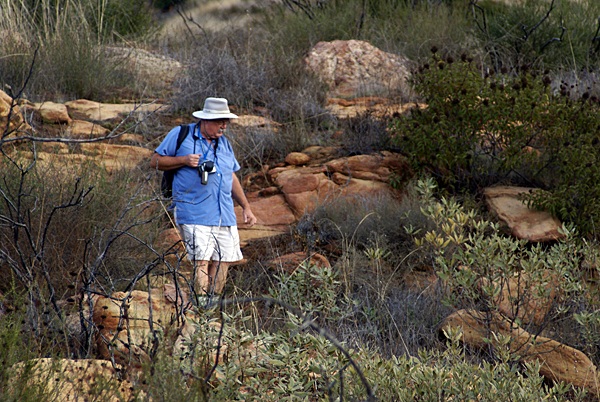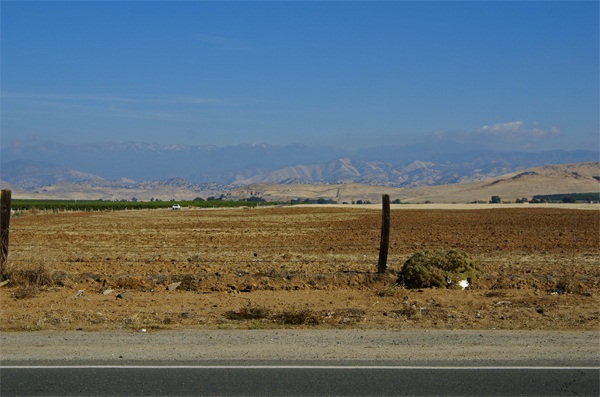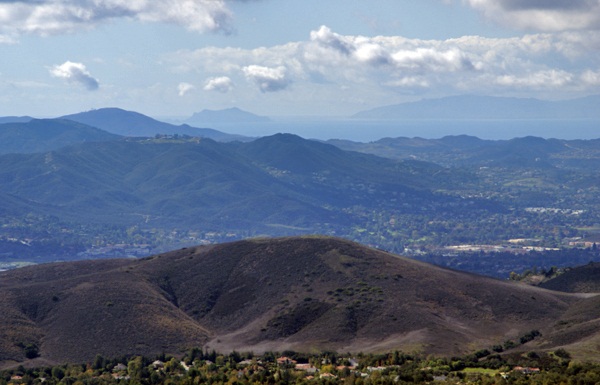Sometimes, when I hide a cache, I like to have the cache tested out by someone else. A beta tester to a geocache serves a couple of important functions for the cache hider. The primary job of the beta tester is to check the coordinates of the cacher.  Sometimes, when the coordinates have been gathered, they aren't necessarily the most accurate.
Sometimes, when the coordinates have been gathered, they aren't necessarily the most accurate.
As I posted in my last post, the accuracy of hand held GPS receivers are only good to about 30 feet. When I got to the degree confluence, my receiver said I was at the point +/- 7 feet. That was pretty good, but thirty feet could be a different story, especially if you're looking for a smaller type of container, which is where the beta tester comes into play.
I've been a beta tester on a couple of caches. I enjoy being a beta tester for a number of reasons. Sometimes, it's interesting to watch a person as they go through their hide process. Other times, it's interesting to see how close our two GPSrs are with regard to signal. Sometimes they're way off and the hider will have to do some checking to see whether it's his unit or mine that appears to be off. It can go either way.
The last time I was a beta tester, I chose to stand several hundred feet away and take pictures of the scenery. I also took a picture after my friend Chaosmanor had hidden his cache and watched as he tried to verify his coordinates. There was no way I could have seen where it was hidden and I actually had a tough time finding his cache, although I shouldn't have since it was fairly exposed from a certain angle. I didn't approach the cache from that particular angle and had a more difficult time finding it.
On another of his cache hides, he called out his coordinates to me and I inputted them into my receiver and then went on the hunt. My receiver sent me over there, which disagreed with his receiver.  But in this case, his receiver was also pointing to where mine had been pointing and so he had to take additional readings to make sure his coordinates were accurate. In this case, it helped having that second GPSr along to verify the coordinates.
But in this case, his receiver was also pointing to where mine had been pointing and so he had to take additional readings to make sure his coordinates were accurate. In this case, it helped having that second GPSr along to verify the coordinates.
The second reason I like to have another cacher beta test my hides is I get to see the reaction of someone finding the cache. On my last hide, CraigsOutside came along on the hike. I had already hidden the cache, but was having some proximity issues with another one of my own caches. This particular multi-cache had to have its second waypoint moved in order to be published. The look on CraigsOutside's face when he found both ends of the cache was priceless. As a cache owner, you only get to rely on the log write-ups of others to see how good the cache is most of the time. When you get to see others attempt your own cache, it furthers the fun.
In reality, I think that every cache hide should have a beta tester. I think many people hide caches too quickly and don't get accurate readings for their cache hides. This leads to frustrations for cache hunters when the coordinates don't end up being very accurate. Even with an accuracy rating of +/- 30 feet, there are things that a cache owner can do to make sure that accuracy is better than that.
Having patience when taking the initial coordinates is probably the first thing that a cache owner can do to insure accurate readings. Taking more than one reading, or averaging the initial reading is always helpful, especially if there is overhead site disturbances, such as trees that could block the signals from the satellites above. Having a beta tester along for the ride will also help, in my opinion.
Pictures were taken at or near the following geocaches:
Sandstone Game Paths - by Chaosmanor
Pathfinder 59s - by Chaosmanor
Friday, November 26, 2010
Beta Testing
Labels: geocaching, Ribbit
Wednesday, November 24, 2010
Degree Confluence
I've always been fascinated with maps. I usually got to ride "shotgun" when we went on family trips. I was the navigator, which meant I got to follow our progress on the road atlas.  It also meant I could suggest routes of travel. Not all were taken, but it was fun to think about that road less traveled. In my travels, I've always enjoyed taking those kinds of roads, as they usually present a different perspective to what I've seen over and over again on other trips.
It also meant I could suggest routes of travel. Not all were taken, but it was fun to think about that road less traveled. In my travels, I've always enjoyed taking those kinds of roads, as they usually present a different perspective to what I've seen over and over again on other trips.
Such was the case over Veteran's Day weekend. Chaosmanor and I planned a trip up to Stockton. The two main routes north are either Interstate 5 or State Hwy 99. My usual route is to take the 99, because I find it slightly more scenic than the 5. More importantly, there seems to be natural breaks along the route, which helps gauge where you are on the trip. There are many towns along the 99 and I know I can usually make it to Bakersfield in around 2 hours, to Fresno in another 2 hours and then to Stockton in approximately another 2 hours.
The 5 is bereft of many cities and town and the scenery is pretty much the same with the exception of the cattle stockyards near Coalinga. Other than that, there's no way to really tell where you are or how long you have to go until you've reached your destination. If you're in a hurry, the 5 is the way to go because it's about a half an hour shorter than the 99. But the main purpose of this trip was to take the scenic route - well scenic in regard to geocaching.
Outside of the geocaches in the major cities along the 99, I've pretty much cleared out most caches along that route. So Chaosmanor suggested we take the less traveled road, parallel to the 99. It would still take us north, but we would avoid most of the larger cities, while driving through open country, which is where you can usually find large numbers of caches without the worry of caches being muggled, or having to worry about crowded situations.
As we made our way north, I saw one of the caches that Chaosmanor had added to his route. Many caches like this I've found in the past usually are mystery caches, not actually near the geographic coordinates that are posted on the cache page. This one, however, was a regular with coordinates N 36˚ W 119˚. This would be a degree confluence, one of many points on the earth where a line of latitude and longitude intersect.
According to the Degree Confluence Project, you are within 49 miles of a degree confluence anywhere you happen to be. Just because you're close, doesn't mean that you can necessarily access these points, however. If you think about it, you'll realize that 70% of the degree confluences fall in water and are difficult to access. Many more fall on rough terrain. Although a map is flat, the world isn't and we have to take into account the lay of the land. But there are some, like the one we visited, that are very easy to access.
The confluence point was literally by the side of a road. To the west, was a large orange grove. To the south and north, the road traveled onward. To the east, the view was of foothills and in the distance, the Great Western Divide which makes up that portion of the Sierra Nevada. There was a slight dusting of snow on top of the mountains. I'm sure there's a lot more snow up there now as we've had several winter storms come through California in the past week.
 For a map nut like myself, this was kind of cool to visit. You see all of those lines on a map, yet often don't really think that much about why they're there. These imaginary lines are the basis of GPS technology. They tell us where we are and because of mathematical formulas, GPS receivers can take electronic signals from satellites in outer space and also tell us where we are, with a great degree of accuracy. Most receivers are usually good to within 30 feet of accuracy. And that's where the fun comes in with geocaching. The receivers get you close, but then you have to do the rest.
For a map nut like myself, this was kind of cool to visit. You see all of those lines on a map, yet often don't really think that much about why they're there. These imaginary lines are the basis of GPS technology. They tell us where we are and because of mathematical formulas, GPS receivers can take electronic signals from satellites in outer space and also tell us where we are, with a great degree of accuracy. Most receivers are usually good to within 30 feet of accuracy. And that's where the fun comes in with geocaching. The receivers get you close, but then you have to do the rest.
According to my GPS receiver, I was within 7 feet of the confluence, based upon the accuracy of my unit at the time I took that picture. You can also see that each of our receivers didn't agree, as I later took a picture of Chaosmanor attempting to zero his receiver out. He was standing about 15 feet away from me while I was at my ground zero point.
After I found the cache, which was hidden nearby, I discovered that my receiver had decided to creep a little bit to the west, closer to my friend's point of confluence. This isn't uncommon. When we go out caching, our units very rarely agree on a particular point, but usually get us close. For $200, I'll not quibble about slight inaccurate readings I received that day. The point is, I was the closest I've ever been to a degree confluence with fairly accurate readings. And from a geek standpoint, it really is kind of cool to see all those zeroes show up on your GPS screen.
Pictures were taken at or near the following geocache:
Confluence N36 00.000 and W119 00.000 - by TheeSugaBear
Labels: Degree Confluence Project, geocaching, Ribbit
Friday, November 5, 2010
On a clear day...
In November, Los Angeles gets treated to the annual U.C.L.A./U.S.C. football game. An old saying I've heard in the past was, "On a clear day, U.C.L.A. . . . . . . . . on any other day, U.S.C. Obviously, this one was created by a Trojan fan, but if this past week is any indication, U.S.C. might be in trouble this year.  But this entry is not about college football.
But this entry is not about college football.
Last Saturday, I went on a hike with my friend Chaosmanor in the Agoura Hills area of the Los Angeles Basin. We'd planned a trip to get us several geocaches, plus a virtual flag that would score me the maximum number of points in the game. We found several caches before heading up to the trailhead to begin our hike.
The first part of the hike was on a new trail open for about a year or so. Surprisingly, it had no caches on the trail, so Chaosmanor took it upon himself to hide a couple while on our way. Soon after those hides, we were on a fire road heading up to some caches that hadn't been found in exactly a year. Well, they still haven't been found. One cache we started to attempt, but didn't finish, mainly because the terrain had changed slightly in the past year. There was a lot of plant growth, which concealed the main way up to the cache and any other route that we could see, looked extremely treacherous and so we passed on it.
The second cache was similar, so we didn't even make an attempt to get up to it. The third cache was attempted after a nice lunch at the end of the fire road on which we'd hiked. This one was probably the most frustrating of the three since we were able to hike up to the cache site and do a very thorough search of the area. After calling a lifeline, we were pretty much able to verify where the cache probably had been, but we couldn't find the ammo can that had been placed there.  We did find, what appeared to be two Asian memoriasl, complete with pictures in nearby alcoves. The only thing we could possibly think that could have happened was that whoever put those pictures up there, took the cache for some reason.
We did find, what appeared to be two Asian memoriasl, complete with pictures in nearby alcoves. The only thing we could possibly think that could have happened was that whoever put those pictures up there, took the cache for some reason.
After striking out there, we headed further up along a game trail and found another more established trail that took us up to the virtual flag and a couple of other caches, including a virtual cache at the top of Simi Peak, just inside the Santa Monica Mountains National Recreation Area. This stop was probably the highlight of the day.
The peak is only 2403 above sea level. I was able to verify that with a laminated sheet at the peak. I put my GPSr down next to the sheet and eventually, it also read the same elevation above sea level. Just after I took the picture, the elevation on my GPSr changed again. I've noticed that on other occasions as well, so I'm not ready to say that my GPSr has great accuracy when it comes to elevation, just that I was able to get the two numbers to coincide.
That didn't make the highlight reel though. What made this spot truly noteworthy was the view. Even though we were at fairly low altitude, we had a complete 360˚ view which stretched for miles and miles, literally. Originally, I had been looking to the west from the peak. Chaosmanor had already pointed out the ocean from further down, but once we got on top of the peak, we spotted Anacapa Island and behind it, Santa Cruz Island, both within Channel Islands National Park. Looking at the map, it looks like we were at least 30 miles, probably more distant from those two islands.
Then we got a bigger shock, I believe, when we looked south and could see the ocean and Catalina Island in the distance.  Catalina Island 26 miles from the mainland, while Anacapa and Santa Cruz are closer to the mainland. It's become a rather rare occurrence when one can see Catalina Island. It's usually obscured by haze, smog and fog, usually a combination of all three. It definitely was a treat to see it so clearly in the distance that day.
Catalina Island 26 miles from the mainland, while Anacapa and Santa Cruz are closer to the mainland. It's become a rather rare occurrence when one can see Catalina Island. It's usually obscured by haze, smog and fog, usually a combination of all three. It definitely was a treat to see it so clearly in the distance that day.
The weather conditions were just right that day where we were. Other hikers might not be so fortunate, but hopefully, that won't stop them from coming up there. I can imagine that peak in fog. That would give an entirely different perspective to the area, that's for sure. We spent a great deal of time up there, getting the necessary information to fulfill the requirements, take pictures of the scenery, take pictures of the benchmark that's also at the top and also just to enjoy the view. It's not often that the Los Angeles area is that clear. Besides the ocean views, we also had amazing views of Simi Valley to the north and the San Fernando Valley to the east. It was a picture perfect day.
Eventually, we knew we'd have to descend back into civilization and we did it reluctantly. We hiked down the trail heading to other geocaches further down the slopes of Simi Peak. At one point we missed a trail junction and ended up further north than we had originally anticipated being, so that added another mile or so to our overall hike, but it was definitely worth the effort. It had been a good climb up and a good hike totally just over 8 miles. It had been a good day.
Pictures were taken at or near the following geocache:
Simi Peak Returns - by WM6P
Labels: 5%, geocaching, hike, Ribbit, virtual flags


